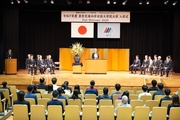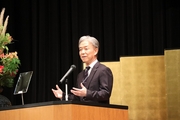イベント報告 2025/10/09
10月2日(木曜日)、ミレニアムホールにおいて令和7年度秋学期入学式を挙行しました。
本学では、国内外を問わず、また出身大学での専攻にとらわれず、高い基礎学力を持った学生あるいは社会で活躍中の研究者・技術者などで、将来に対する明確な目標と志、先端科学技術分野に対する強い興味と意欲を持った者の入学を積極的に進めており、このたび、87名の新入生を本学に迎えました。
【入学者数】
(博士前期課程)
先端科学技術研究科 39名(うち留学生35名)
(博士後期課程)
先端科学技術研究科 48名(うち留学生38名)
総計 87名(うち留学生73名)
【塩﨑学長式辞】
Fall Welcome 2025
Hello, everyone. On behalf of our faculty and staff, I am delighted to welcome you all to our university. Today, 87 new students from 17 countries and regions, including Japan, are joining NAIST.
As a university community rich in diversity, NAIST declared in 2022 to be a "co-creative community." Our "Declaration of Co-creative Community" says:
The Co-creative Community we aspire to is a community where members strive
for the creation of new value through the exchange of opinions with courtesy
and empathy. We value our individual differences and pursue mutual
understanding and respect while rejecting discrimination.
The entire Declaration is on our university website and also posted at the entrance of each Division building. Please make time to read it.
We are proud that you have chosen NAIST as your place for graduate study. The learning in graduate school is quite different from that in college. Although there are some lecture courses, the characteristic feature of graduate education, including that at NAIST, is research-oriented training, where you learn by working on your research projects. However, the research you will conduct at NAIST is not just "a laboratory course" to master what has already been established. You will be engaged in cutting-edge research to acquire knowledge and technologies that are new to humanity. A well-known example of such research is that of Prof. Shinya Yamanaka and his graduate students at NAIST, who successfully created iPS cells that were later recognized with a Nobel Prize.
If you haven't already done so, I invite you to visit the Large Lecture Hall in our Division of Biological Science building. By the entrance door of the lecture hall, you can read a message from Prof. Yamanaka on a brass plaque that commemorates his Nobel Prize. There he says:
In baseball, players with a batting average of 30% are considered great. But in
research, a 10% success rate is excellent. In addition, the tenth successful
attempt cannot usually be performed until the nine unsuccessful attempts have
been completed. So, without fear of what will result, try your hardest and make
mistakes.
What Prof. Yamanaka says is invaluable advice that prepares you for graduate training. In high school and college science classes, we just learn about the results, not the process. Students often believe that scientific research always follows a series of logical steps to provide a direct answer to a given question. If you began your thesis project with such a perception of research, you would be miserable and stressed out every time your experiment failed. However, if you know beforehand that a 10% success rate is considered excellent in research, you can feel better and be more prepared for further attempts.
But "a 10% success rate is excellent" means the actual success rate might be below 10%. It could be 5%, 1%, or 0.1%. You keep trying for a day, a week, a month, or a year, and eventually you may start feeling lost and desperate. Eminent systems biologist Uri Alon referred to such a situation as "the cloud." In the cloud, you lose the sense of direction, like a pilot flying in dense fog. He says this cloud is an inherent part of research, standing between the known and the unknown. Therefore, to reach the unknown, which is a discovery, we must plunge into "the cloud".
In Hayao Miyazaki's animated fantasy movie "Castle in the Sky," Pazu and Sheeta, in a glider, are blown into the clouds of a lightning storm. They suddenly come out of the clouds and arrive in a calm blue sky, discovering the legendary flying castle Laputa. You may wonder how you can navigate yourself through the blinding cloud that hinders you from making a discovery. Is a favorable wind the only way to break through the cloud, as happened to Pazu and Sheeta? Professor Alon suggests that solidarity and support can help to get out of the cloud.
That is why you will join a laboratory at NAIST. At the forefront of scientific and technological research, you try to discover or achieve something novel, something that has not been accomplished by anybody else, including your professors. So, even your professors cannot tell you precisely what to discover or how to achieve your research goals. However, they are experienced copilots who are willing to fly through "the cloud" with you. Our faculty members are world-class researchers, and they are looking forward to collaborating with you.
With the help of your professors and colleagues in the laboratory, you try, try, and try to go through the turbulent stormy cloud. Suddenly, you come to a calm, blue sky, where you catch your first glimpse of an unexpected discovery. Such an experience in graduate study will equip you with abilities and skills that expand your potential in diverse contexts of your life, as concisely stated in our school motto: Outgrow your limits.
A number of exciting laboratories are just part of the remarkable environment of our campus that allows you to "Outgrow your limits." I encourage you to make the most of your studies at NAIST, taking advantage of this unique environment where you can interact with and learn from our diverse academic community, as well as our local and international collaborators.
Enjoy "the cloud" and outgrow your limits!
※参考 日本語訳
実際の式辞は英語で行われました。
2025年10月入学式 学長式辞
はじめまして。教職員を代表して、皆さんを本学に心から歓迎いたします。本日、日本を含む17の国と地域から87名の新入生が本学、奈良先端科学技術大学院大学(NAIST)に加わりました。
多様性に富んだ構成員を有する大学として、本学は2022年に「共創コミュニティー宣言」を策定し、次のような「共創コミュニティー」を目指すことを宣言しました:
本学が目指す「共創コミュニティー」とは、私たち構成員の各自が互いの多様性を認識し、相互の理解と尊重に努めるとともに、差別を認めず、相手に対する敬意と思いやりの下での意見交換をとおして、新たな価値の創造を目指す共同体です。
この「共創コミュニティー宣言」の全文は、本学のウェブサイトに掲載しているほか、各研究棟の入り口にも掲示しています。ぜひ読んでおいてください。
皆さんが大学院での学びの場としてNAISTを選んでくださったことを、誇りに思います。大学院での学びは大学学部でのそれとは大きく異なります。講義科目もありますが、NAISTを含む大学院での教育の特徴は、研究指導が中心であるということで、自ら研究課題に取り組むことで学びを積み重ねます。ただし、皆さんがNAISTで行う研究は、既知のものを習得するための「実習」ではありません。人類にとって未知の知識や技術を獲得する、最先端の研究に挑戦するのです。よく知られている例としては、NAISTでiPS細胞の作製に成功し、後にノーベル賞を受賞した山中伸弥教授とその研究室の大学院生による研究があります。
まだ行ってみたことがない方は、ぜひバイオサイエンス領域棟の大講義室に行ってみてください。その入口脇に山中教授のノーベル賞受賞を記念する銘板があり、次のような山中先生からのメッセージが刻まれています:
野球の打率は3割あれば名選手ですが、研究は1割でも当たったら優秀です。しかも、9回失敗しないと、なかなか1回の成功が手に入りません。ですから、恐れることなく、思い切って挑戦し、たくさん失敗してください。
山中教授の言葉は、大学院での研究生活を始める皆さんにとって極めて有益な助言です。高校や大学の学部での科学の授業では、私たちは「結果」だけを学び、「過程」を学ぶことはあまりありません。そのため、研究というものは、常に論理的な手順に沿って直ちに答えを導き出すものだと思い込んでしまいがちです。そのようなイメージを持ったまま、大学院の学位論文研究を始めてしまうと、実験が失敗するたびに惨めな気持ちになり、強いストレスを感じるでしょう。しかし、「研究は1割でも当たったら優秀」と最初から知っていれば、そう落ち込むことなく頑張り続けることもできるでしょう。
ただし、「研究は1割でも当たったら優秀」ということは、実際には1割を下回ることもあるという意味です。成功率が5%、1%、あるいは0.1%ということもありえます。1日、1週間、1か月、あるいは1年と頑張っているうちに、次第に途方に暮れて絶望さえ感じるかもしれません。著名なシステム生物学者であるUri Alon教授は、このような状況を「cloud (雲)」と呼びました。cloudの中では濃霧の中を飛ぶパイロットのように方向感覚を失ってしまいます。アロン教授は、cloudは研究活動の本質的な一部であり、「既知」と「未知」の間に立ちはだかるものであると言います。ですから、「未知」、つまり新発見に到達するためには、cloudにまず飛び込まなければならないのです。
宮崎駿監督のアニメ映画『天空の城ラピュタ』では、パズーとシータの乗ったグライダーが雷雲に巻き込まれます。そして突然、雲を抜けて青空へと抜け出たとき、伝説の天空の城ラピュタを発見するのです。それでは、発見への道に立ちはだかっているcloudを突破するにはどうしたらよいのでしょう。パズーとシータのように幸運な風に頼るしかないのでしょうか。Alon教授は、「連帯とサポート」がcloudを抜け出す助けになると言います。
だからこそ、皆さんは研究室に所属するのです。最先端の科学技術研究においては、これまで誰も成し遂げていないこと、教授ですら知らないことに挑戦します。つまり、研究室の教授でさえ、何を発見すべきか、あるいは研究目標を達成するための方法を、的確にあなたに教えることはできないのです。しかしながら、先生方は経験豊富な「副操縦士」として、皆さんと一緒にcloudの中を飛行し、くぐり抜けてくださいます。本学の教員は世界トップクラスの研究者であり、皆さんとの共同研究を楽しみにしています。
教授や研究室の仲間のサポートを得ながら、嵐のような風の吹き荒れるcloudの中をひたすら進んでいるうちに、突然、穏やかな青空が広がり、予想もしていなかったような発見が目に飛び込んでくる。そんな大学院での経験が、人生のさまざまな場面で活かせる皆さんの潜在能力を拡げるのに必要な力や技能を培うのであり、本学の校訓 "Outgrow your limits"の言わんとするところでもあります。
数多くの魅力的な研究室をはじめ、本学のキャンパスには皆さんの"Outgrow your limits"を実現するための素晴らしい環境が整っています。多彩な学術コミュニティ、そして国内外の研究者と交流し、学ぶことができるこの特別な環境を最大限に活かしてください。
Enjoy "the cloud" and outgrow your limits!
2025年 10月2日
奈良先端科学技術大学院大学
学長 塩﨑 一裕








